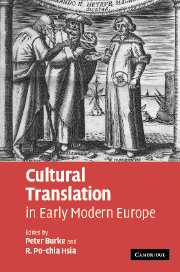Book contents
- Frontmatter
- Contents
- Notes on contributors
- Introduction
- PART I TRANSLATION AND LANGUAGE
- PART II TRANSLATION AND CULTURE
- 5 Early modern Catholic piety in translation
- 6 The translation of political theory in early modern Europe
- 7 Translating histories
- 8 The Spectator, or the metamorphoses of the periodical: a study in cultural translation
- PART III TRANSLATION AND SCIENCE
- Bibliography
- Index
7 - Translating histories
Published online by Cambridge University Press: 27 July 2009
- Frontmatter
- Contents
- Notes on contributors
- Introduction
- PART I TRANSLATION AND LANGUAGE
- PART II TRANSLATION AND CULTURE
- 5 Early modern Catholic piety in translation
- 6 The translation of political theory in early modern Europe
- 7 Translating histories
- 8 The Spectator, or the metamorphoses of the periodical: a study in cultural translation
- PART III TRANSLATION AND SCIENCE
- Bibliography
- Index
Summary
Following the anthropological model suggested in the introduction, this chapter will examine translations of historical works as evidence of what readers in different countries found particularly interesting or alien in other cultures in the early modern period. A survey of general trends will be followed by case studies of the translations of Francesco Guicciardini's History of Italy and Paolo Sarpi's History of the Council of Trent.
What exactly counts as a work of history is not as easy to decide as one might think. The term ‘history’ itself in different languages, from the ancient Greek historia onwards, presents a challenge to translators. The frontier between history and fiction was a porous one, and some scholars may object to the inclusion here of translations of Eustache Le Noble's quasi-historical works. The frontier between history and biography was also open. In what follows, biographies are generally omitted, but they are included in the cases of Alexander the Great, Charles II of England, the emperor Charles V, Charles IX of Sweden, Columbus, Cromwell, Gustavus Adolphus, Henry IV of France, Henry VII of England, the emperor Leopold, Louis XI, Olivares, Philip of Spain, Richelieu, Sebastian of Portugal, Pope Sixtus V and Wallenstein.
What counts as a translation is equally difficult to say with any precision. For example, a book by the Tuscan humanist Leonardo Bruni about the Goths is sometimes described as a free translation of Procopius and sometimes as an original (though derivative) work (‘stolen’ according to Gibbon), which was itself translated into Italian, French, German and English.
- Type
- Chapter
- Information
- Cultural Translation in Early Modern Europe , pp. 125 - 141Publisher: Cambridge University PressPrint publication year: 2007
- 1
- Cited by



